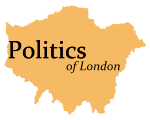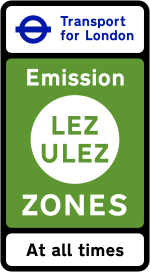London low emission zone
Number plate recognition | |
| Operator | Capita (from 2015) |
|---|---|
| Manager | Transport for London |
| Currency | GBP |
| Retailed |
|
| Website | Official page |
| This article is part of Politics of London |
 |
The London Low Emission Zone (LEZ) is an area of London in which an
The current standard for large commercial vehicles (over 3.5 tonnes) is Euro VI, increased from Euro IV on 1 March 2021. Vehicles need to meet these standards or face a penalty of £100 per day. The new rules were due to come into force in October 2020 but were postponed due to the 2020 coronavirus pandemic.[1]
History
Since 1993, the
In 2000 one measuring site exceeded EU limits for air pollution, pollution rose for two years prior to 2007.[3][4][5] The Green Party reported that nine sites in London exceeded the EU limits for air pollution in 2007.[6] The A23 at Brixton suffered the most consistently high levels for more than two-fifths of the period. Carbon monoxide levels had reduced rapidly during the late 1990s and been relatively stable since 2002.
In 2007
Planning
Towards the end of 2006, the Mayor of London, Ken Livingstone, proposed changing the congestion charge fee, from being a flat rate for all qualifying vehicles, to being based on Vehicle Excise Duty (VED) bands.[8]
VED bands for new vehicles are based on the results of a laboratory test, designed to calculate the theoretical potential emissions of the vehicle in grammes of CO2 per kilometre travelled, under ideal conditions. The lowest band, Band A, is for vehicles with a calculated CO2 value of up to 100
Under the proposed modifications to the scheme, vehicles falling into Band A would have a reduced, or even zero charge, whilst those in Band G would be charged at £25 per day. Certain categories of vehicle, such as electric vehicles, are already exempt from the charge.[10][11] These proposals were put out to public consultation in August 2007.[12]
In early 2006, consultations began on another charging scheme for motor vehicles entering London. Under this new scheme, a daily charge would be applied to the vehicles responsible for most of London's road traffic emissions, commercial vehicles—such as lorries, buses, and coaches, with diesel engines. Cars were explicitly excluded. The objective of the new scheme is to help London meet its European Union (EU) air pollution obligations—specifically the EU Air Quality Framework Directive—as part of the Mayor's programme to make London the greenest city in the world. Despite some opposition, on 9 May 2007 the Mayor confirmed that he would proceed with a London Low Emission Zone, focused entirely on vehicle emissions, that plans to reduce emissions overall by 16% by 2012.[3]
Introduction


The LEZ came into operation on 4 February 2008[13] with a phased introduction of further provisions as increasingly tough emissions standards apply.[14] Vehicles registered after October 2001 are generally compliant with the first stages of the zone when Euro 3 engine compliance was the mandatory requirement.
The regulations were tightened in July 2008 with more vehicles types included.
On 2 February 2009 the Mayor of London, Boris Johnson, announced his intention to cancel the third phase of the LEZ covering vans from 2010, subject to the outcome of a public consultation later in the year.[15] The Freight Transport Association welcomed this move in its 3 February press release.[16] The scheme was fully implemented on 3 January 2012.
For London Buses, since January 2012 a new Low Emission Zone (LEZ) was adopted, with those older buses selectively phasing out (those with no electronic destination displays and more than 12 years old) and the remaining buses were converted to Euro 3 or 4 standards. The new Low Emission Zone (LEZ) rules will be implemented from 2015, thus allowing all the Euro II vehicles and Euro III without catalytic standards to be removed. In July 2016 the last bus not meeting the standards was withdrawn.[citation needed]
Tougher standards from 2021
From 1 March 2021, all large commercial vehicles in London need to meet Euro VI standards or face a penalty of £100 per day. Commercial vehicles which do not meet the older standards (Euro IV) are charged £300 per day.[17]
Statistics from TfL showed that the number of vehicles complying rose to nearly 90% upon the introduction of tougher standards in March 2021, up from 70% in May 2019.[18] All buses in London meet the Euro VI standards, with an increasing number becoming zero emission.[19]
Timeline
Applicable vehicles over the implementation phase:[14]
| Vehicle | Feb 2008 | Jul 2008 | Jan 2012 | Mar 2021 |
|---|---|---|---|---|
Lorries (over 12 tonnes ) |
Euro III |
Euro IV |
Euro VI
| |
| Lorries (3.5–12 tonnes), buses and coaches | n/a | Euro III | Euro IV | Euro VI |
| Minibuses and vans (1.205-tonnes) | Euro 3 | |||
Motor caravans and ambulances (2.5–3.5 tonnes)[14] |
Euro 3 | |||
Operation

The zone covers most of
- Lorries, buses, and coaches that meet the Euro 6 emission standard.
- Vans and minibuses not exceeding 3.5 tonnes
- All cars and motorcycles
Non-GB registered vehicles that meet the required LEZ standards will need to register with TfL; most compliant GB registered vehicles do not.[22] Owners of vehicles that do not meet the above requirements have a number of options:[23]
- Fit a filter
- Replace the vehicle
- Reorganise their fleet to only use compliant vehicles in London
- Convert to natural gas
- Pay the charge (from £100 to £200 for each calendar day that the vehicle travels within the zone)[24]
The zone is monitored using automatic number plate reading cameras (
Reaction
The scheme was opposed during the consultation phase by a range of interested parties: The
Related schemes
T-Charge
In October 2017, London Mayor
Ultra Low Emission Zone
The ULEZ, which went into effect on 8 April 2019,[32] initially covered the same area as the T-Charge but applies 24/7, 365 days a year, with charges of £12.50 a day for cars, vans and motorcycles, and £100 a day for lorries, buses and coaches. One month after its introduction, the number of the worst polluting vehicles entering the zone each day had dropped from 35,578 to 26,195.[33] The zone was extended to the North Circular and South Circular roads on 25 October 2021.[34][35] It was expanded again on 29 August 2023 to coincide with the low emission zone, covering almost all of Greater London.[36]
See also
- Ecopass (Milan)
- Great Smog
- London congestion charge
- Low-emission zone
- Motoring taxation in the United Kingdom
- Road pricing in the United Kingdom
References
- ^ "Transport for London to temporarily postpone enforcement of new stricter rules for freight vehicles on the capital's roads". Transport for London.
- ^ Fuller & Green (28 July 2006). "Air Quality In London 2005 and mid 2006 – Briefing" (PDF). London Air Quality Network. Retrieved 8 January 2008.
- ^ a b c d e "£200 pollution charge for lorries". BBC News. British Broadcasting Corporation. 9 May 2007. Retrieved 22 November 2007.
- ^ Tibbetts, Graham (2 February 2008). "Spy camera identifies polluting drivers". The Daily Telegraph. Archived from the original on 24 August 2007. Retrieved 25 November 2007.
- ^ Dodson, Sean (20 July 2006). "The lighter route to cleaner air". The Guardian. Guardian News and Media. Retrieved 2 February 2008.
- ^ "City roads breach pollution limit". BBC News. British Broadcasting Corporation. 25 September 2007. Retrieved 25 November 2007.
- ^ a b Millward, David (5 November 2007). "School minibuses to be hit by pollution charge". The Daily Telegraph. Archived from the original on 5 November 2007. Retrieved 25 November 2007.
- ^ McLaren, Elsa; Agencies (14 November 2006). "Gas-guzzlers face £25 congestion charge". The Times. UK: News Corporation Ltd. Retrieved 20 January 2008.
- ^ English, Andrew (6 October 2007). "Fuel's gold – the cost of carbon emissions". The Daily Telegraph. Archived from the original on 11 October 2007. Retrieved 20 January 2008.
- ^ Simon Jeffery and Sarah Phillips (7 August 2006). "Q&A: The congestion charge". The Guardian. Guardian News and Media. Retrieved 26 May 2007.
- ^ Webster, Ben (13 July 2006). "Congestion charge will rise to £25 for 'Chelsea tractors'". The Times. News Corporation Ltd. Retrieved 26 May 2007.
- ^ "Polluting cars C-charge discussed". BBC News. British Broadcasting Corporation. 10 August 2007. Retrieved 25 November 2007.
- ^ "London's poor air quality tackled with launch of Low Emission Zone". Transport for London. 4 February 2008. Retrieved 2 November 2023.
- ^ a b c "Emissions standards". Transport for London. Retrieved 21 November 2007.
- ^ "Reprieve for small businesses as Mayor suspends phase three of Low Emission Zone". Archived from the original on 10 February 2009.
- ^ "Low Emission Zone U-turn: victory for logistics and small business".[permanent dead link]
- ^ "Check your Vehicle". tfl.gov.uk.
- ^ "New tighter Low Emission Zone standards for HGVS introduced in London". March 2021.
- ^ "London's buses now meet ULEZ emissions standards across the entire city". Transport for London. 14 January 2021. Retrieved 7 August 2021.
- ^ "The Low Emission Zone. Cleaner air for Greater London" (PDF). Transport for London. pp. 10–12. Archived from the original (PDF) on 4 June 2011. Retrieved 25 November 2007.
- ^ "Which vehicles are affected?". Transport for London.
- ^ "Do I need to register". Transport for London.
- ^ "What are my options". Transport for London.
- ^ "pay the charge". Transport for London.
- ^ a b "Enforcement". Transport for London. Retrieved 21 November 2007.
- ^ "Capita to lose congestion charge". BBC News. British Broadcasting Corporation. 25 October 2007. Retrieved 21 November 2007.
- ^ "LEZ consultation". Freight Transport Association.[permanent dead link]
- ^ "Diesel Tax - Complete Guide to the 'Toxin Tax' For Diesel Cars • Motorway". Motorway. Retrieved 13 November 2017.
- ^ Mason, Rowena (17 February 2017). "London to introduce £10 vehicle pollution charge, says Sadiq Khan". The Guardian. Retrieved 23 February 2017.
- ^ Saarinen, Martin (17 February 2017). "London introduces new £10 'T-Charge' to cut vehicle pollution". Auto Express. Retrieved 23 February 2017.
- ^ Kimiko de Reytas-Tamura (17 February 2017). "A Push for Diesel Leaves London Gasping Amid Record Pollution". The New York Times. Retrieved 23 February 2017.
- ^ "London's new pollution charge begins". BBC News. 8 April 2019. Retrieved 8 April 2019.
- TheGuardian.com. 16 May 2019.
- ^ "ULEZ: The politics of London's air pollution". BBC News. 5 April 2019.
- ^ "Londoners get ready for expansion of low emission zone". Financial Times. 24 October 2021.
- ^ "ULEZ: Ultra Low Emissions Zone to cover all of London". BBC News. 25 November 2022.

